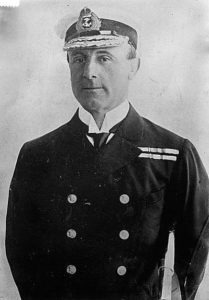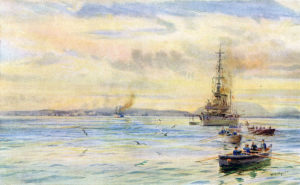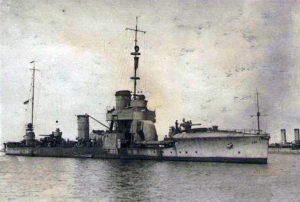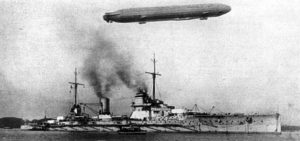The Titanic clash between the British Grand Fleet and the German High Seas Fleet on 31st May 1916

German Battleships turn away on coming under fire from the British Grand Fleet at the Battle of Jutland 31st May 1916
The previous battle of the First World War is Gallipoli IV
The next battle of the First World War is the Battle of Jutland Part II
Battle: Jutland
Date: 31st May 1916
Place: In the North Sea off the coast of Denmark
War: The First World War
Contestants: The British Royal Navy against the Imperial German Navy
Admirals: Admiral Sir John Jellicoe commanded the Royal Navy’s Grand Fleet. Vice Admiral Sir David Beatty commanded the British Battle Cruiser Fleet. Admiral Reinhard Scheer commanded the German High Seas Fleet. Vice Admiral Franz Hipper commanded the German Battle Cruiser Squadron.
General:
The opposing fleets comprised battleships, battle cruisers, light cruisers and destroyers. The British Grand Fleet alone deployed heavy or armoured cruisers. The Germans considered such ships to be inadequately gunned and armoured for a fleet action. The fate of Admiral Arbuthnot’s cruiser squadron at Jutland seems to have borne out the German view.
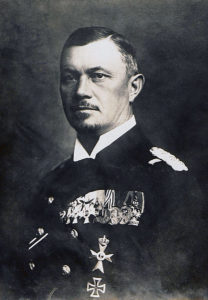
Admiral Reinhard Scheer Commander in Chief of the German High Seas Fleet at the Battle of Jutland 31st May 1916
The British Grand Fleet had two seaplane carriers one of which was present at the Battle of Jutland.
In addition support was provided by submarines.
In the Royal Navy the class of ship originally termed ‘torpedo boat destroyer’ by the Great War had been abbreviated to ‘destroyer’. The German navy did not have an equivalent term. The smaller German vessels were referred to as ‘torpedo boats’, whether they were what the Royal Navy would have classed as torpedo boats or destroyers. Smaller vessels in the Imperial German Navy were given an initial and a number as with Royal Navy submarines.
The larger ships were armed with secondary armaments in addition to their main gun armament. The secondary armament was primarily intended to combat attacks by light cruiser and destroyers. Virtually all the ships at Jutland were armed with torpedo tubes.
The ships at the Battle of Jutland were powered by coal with the exception of the four Queen Elizabeth battleships and the modern classes of British destroyer powered by oil. Speeds of around 25 knots were achievable by the battle cruisers, newer light cruisers and destroyers. The Dreadnought battleships on each side had an effective maximum speed of around 20 knots, other than the Queen Elizabeths which could reach 24 knots.

Royal Navy’s Grand Fleet at anchor in the Firth of Forth in 1916: photographed from Royal Navy Airship R9
Scheer significantly reduced the battle speed of his fleet by including the pre-Dreadnoughts of the 2nd Battle Squadron, which effectively reduced his maximum battle speed to around 17 knots.
The wide use of coal by dozens of ships manoeuvring at high speed in the battle area generated considerable quantities of black smoke making it difficult to identify opposing ships and to direct shooting. On the other hand smoke screens were twice used by the German Fleet during the Battle of Jutland to break away from the British.

Destroyers generating a smoke screen at sea. On two occasions during the Battle of Jutland on 31st May 1916 German destroyers set up a smoke screen to conceal from the British that the German battle line was turning away to escape from the British battleships’ shellfire
At Jutland visibility was further hampered by the changes of weather bringing localised mist and squalls and the onset of darkness early in the battle.
All ships were fitted with wireless radio. Messages by wireless were encoded and sent using Morse code. Wireless was in its infancy and had only been recently introduced in the two navies. There was limited experience in its use. It was susceptible to atmospheric interference and could be relatively easily jammed. Several key wireless messages were not received during the Battle of Jutland.
Limited experience and training in the use of wireless as a signal medium led to confusion and ambiguity in the wording of messages.
Flag, semaphore and lamp signals were used between ships in visual touch.
First World War breech loading quick firing guns were capable of firing substantial distances. The larger guns were capable of firing up to several miles. Gun control was by sight.
The British Battleships and Battle Cruisers were equipped with a central gun control unit situated high up on the superstructure, as were the more modern Cruisers and Light Cruisers. This unit could control the fire of the main armament for co-ordinated broadsides or leave fire control to individual turrets while providing information on ranges and direction. The German Imperial navy did not have centralised fire control units leaving fire control to the turret commanders subject to control by the ship’s captain. Equipment for assessing range and direction were provided in the turrets.

British Battle Cruisers HMS Lion, Princess Royal and New Zealand. These ships all fought at the Battle of Jutland on 31st May 1916 in Admiral Beatty’s Battle Cruiser Fleet
The Royal Navy Grand Fleet Order of Battle on 31st May 1916:
Ship details: The details against each ship are: year of first commissioning-displacement in tons-main armament-fastest speed in knots-crew complement. Figures are in some instances approximate. Records of top speeds for some ships are unreliable as a ship might produce higher or lower speeds in actual trials as against the design speed.
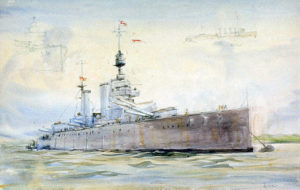
British Battle Cruiser HMS Lion. Lion fought at the Battle of Jutland on 31st May 1916 as Vice-Admiral Sir David Beatty’s flagship: picture by Lionel Wyllie
Battle Cruiser Fleet commanded by Vice-Admiral Sir David Beatty:
1st Battle Cruiser Squadron commanded by Rear-Admiral O. de B. Brock:
HMS Lion 1912-26,270 tons-8X13.5 inch guns-28 kts-1,092
HMS Princess Royal 1912-26,270 tons-8X13.5 inch guns-28 kts-985
HMS Queen Mary 1912-26,770 tons-8X13.5 inch guns-28 kts-1,185
HMS Tiger 1914-28,430 tons-8X13.5 inch guns-28 kts-1,185
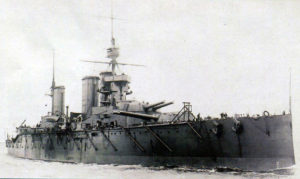
British Battle Cruiser HMS Princess Royal. Princess Royal fought at the Battle of Jutland on 31st May 1916 in Rear¬-Admiral O. de B. Brock’s 1st Battle Cruiser Squadron part of Admiral Beatty’s Battle Cruiser Fleet
2nd Battle Cruiser Squadron commanded by Rear‑Admiral W. C. Pakenham:
HMS New Zealand 1912-18,500 tons-8X12 inch guns-25 kts- 853
HMS Indefatigable 1911-18,500 tons-8X12 inch guns-25 kts- 853
5th Battle Squadron (Battleships) commanded by Rear‑Admiral H. Evan‑Thomas:
HMS Barham 1915-27,500 tons-8X15 inch guns-24 knts-1,000
HMS Valiant 1916-27,500 tons-8X15 inch guns-24 knts-1,000
HMS Warspite 1915-27,500 tons-8X15 inch guns-24 knts-1,000
HMS Malaya 1916-27,500 tons-8X15 inch guns-24 knts-1,000

British Battleships HMS Valiant and HMS Malaya in the Firth of Forth. Both ships fought at the Battle of Jutland on 31st May 1916 in Rear-Admiral Evan-Thomas’s 5th Battle Squadron: picture by Lionel Wyllie
1st Light Cruiser Squadron commanded by Commodore E. S. Alexander‑Sinclair:
HMS Galatea 1914-3,500 tons-3X6 inch guns-28.5 knts-318
HMS Phaeton 1914-3,500 tons-3X6 inch guns-28.5 knts-318
HMS Inconstant 1914-3,500 tons-3X6 inch guns-28.5 knts-318
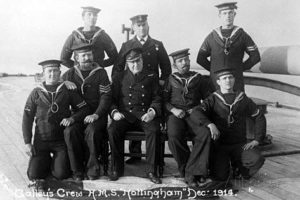
Galley Crew British Light Cruiser HMS Nottingham. Nottingham fought at Battle of Jutland 31st May 1916 in 2nd Light Cruiser Squadron
HMS Cordelia 1914-3,750 tons-4X6 inch guns-28.5 knts-325
2nd Light Cruiser Squadron commanded by Commodore W. E. Goodenough:
HMS Southampton 1912-5,400 tons-8X6 inch guns-25 knts-430
HMS Birmingham 1913-5,400 tons-9X6 inch guns-25 knts-433
HMS Nottingham 1913-5,400 tons-9X6 inch guns-25 knts-433
HMS Dublin 1912-5,400 tons-8X6 inch guns-25 knts-430

British Light Cruiser HMS Yarmouth. Yarmouth fought at the Battle of Jutland on 31st May 1916 in the 3rd Light Cruiser Squadron: picture by Arthur Burgess
3rd Light Cruiser Squadron commanded by Rear‑Admiral T. D. W. Napier:
HMS Falmouth 1910-5,250 tons-8X6 inch guns-25 knts-433
HMS Yarmouth 1911-5,250 tons-8X6 inch guns-25 knts-433
HMS Birkenhead 1915-5,235 tons-10X5.5 inch guns-25 knts-452
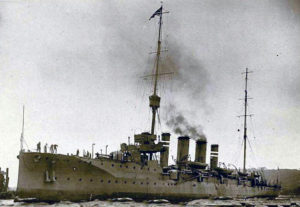
British Light Cruiser HMS Gloucester. Gloucester fought at the Battle of Jutland on 31st May 1916 in the 3rd Light Cruiser Squadron
HMS Gloucester 1900-4,800 tons-2X6 inch & 10X4 inch guns-25 knts-411
HMS Chester 1915-5,185 tons-10X5.5 inch guns-25 knts-402
1st Destroyer Flotilla:
HMS Fearless (light cruiser flotilla leader) 1912-3,440 tons-8X4 inch guns-25 knts-325
HMS Acheron 1911-990 tons-2X4 inch guns-29 knts-70
HMS Ariel 1911-990 tons-2X4 inch guns-29 knts-70
HMS Attack 1911-990 tons-2X4 inch guns-29 knts-70
HMS Hydra 1912-990 tons-2X4 inch guns-30 knts-70
HMS Badger 1911-990 tons-2X4 inch guns-30 knts-70
HMS Goshawk 1911-990 tons-2X4 inch guns-30 knts-70
HMS Defender 1911-990 tons-2X4 inch guns-28 knts-70
HMS Lizard 1911-990 tons-2X4 inch guns-27 knts-70
HMS Lapwing 1911-990 tons-2X4 inch guns-27 knts-70
13th Destroyer Flotilla:
HMS Champion (light cruiser flotilla leader) 1915-3,759 tons-4X6 inch guns-28 knts-324
HMS Nestor 1914-1024 tons-3X4 inch guns-34 knts-80
HMS Nomad 1914-1024 tons-3X4 inch guns-34 knts-80
HMS Narborough 1914-1024 tons-3X4 inch guns-34 knts-80
HMS Obdurate 1914-1024 tons-3X4 inch guns-34 knts-80
HMS Petard 1914-1024 tons-3X4 inch guns-34 knts-80
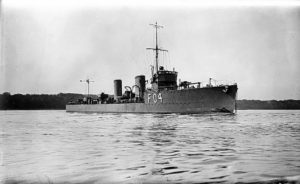
British Destroyer HMS Nerissa. Nerissa fought at the Battle of Jutland on 31st May 1916 in the 13th Flotilla
HMS Pelican 1914-1024 tons-3X4 inch guns-34 knts-80
HMS Nerissa 1914-890 tons-3X4 inch guns-35 knts-79
HMS Onslow 1914-1024 tons-3X4 inch guns-34 knts-80
HMS Moresby 1914-1024 tons-3X4 inch guns-34 knts-80
HMS Nicator 1914-1024 tons-3X4 inch guns-34 knts-80
9th & 10th Destroyer Flotillas:
HMS Lydiard 1914-1003 tons-3X4 inch guns-29 knts-102
HMS Liberty 1913-970 tons-3X4 inch guns-29 knts-77
HMS Landrail 1914-983 tons-3X4 inch guns-29 knts-77
HMS Laurel 1913-970 tons-3X4 inch guns-29 knts-77
HMS Moorsom 1913-1024 tons-3X4 inch guns-34 knts-80
HMS Morris 1913-1024 tons-3X4 inch guns-34 knts-80
HMS Turbulent 1916-1098 tons-5X4 inch guns-32 knts-102
HMS Termagent 1916-1098 tons-5X4 inch guns-32 knts-102
HMS Engadine (Seaplane Carrier) 1911-1676 tons-2X4 inch guns-21.5 knts-4 Short 184 Seaplanes-250
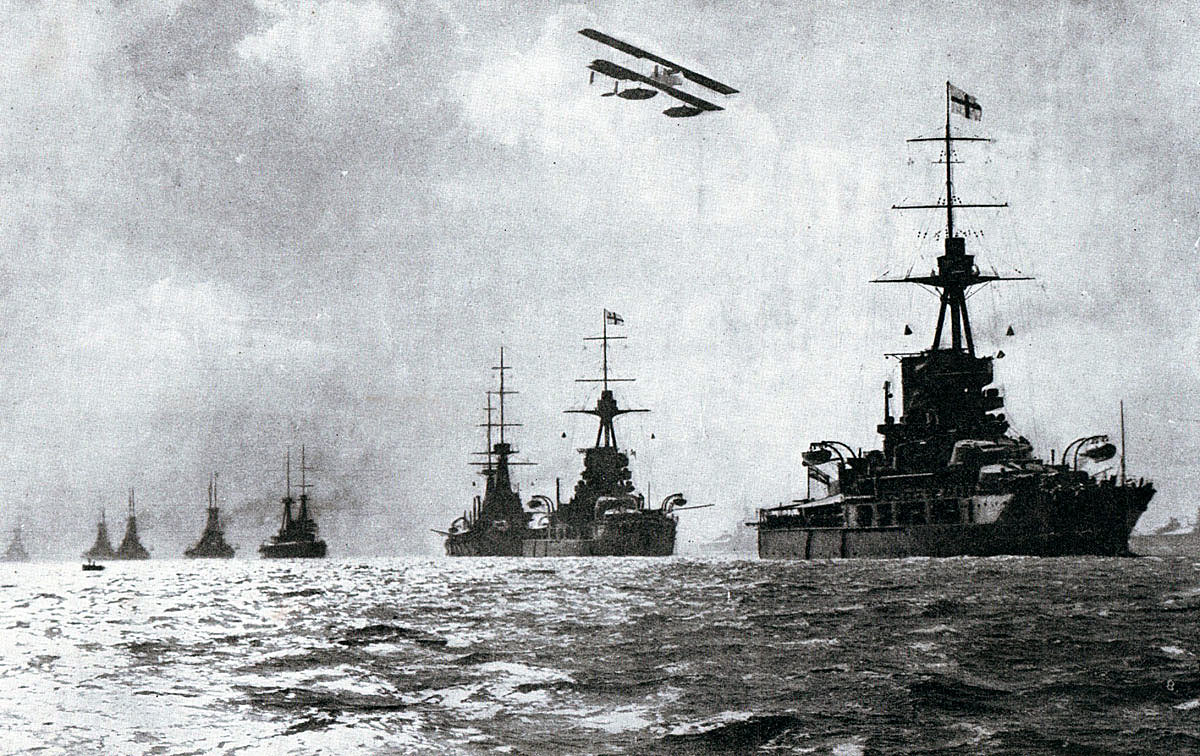
British Grand Fleet at sea. The Grand Fleet was the principal component of Admiral Jellicoe’s force at the Battle of Jutland on 31st May 1916
Grand Fleet:
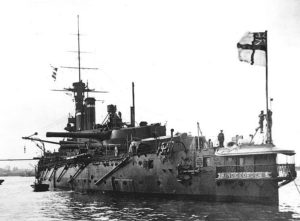
British Battleship HMS King George V. King George V fought at the Battle of Jutland on 31st May 1916 in Vice Admiral Sir Thomas Jerram’s 2nd Battle Squadron
2nd Battle Squadron (Battleships) commanded by Vice‑Admiral Sir Thomas Jerram:
HMS King George V 1912-23,000 tons-10X13.5 inch guns-21 knts-830
HMS Ajax 1913-23,000 tons-10X13.5 inch guns-21 knts-830
HMS Centurion 1913-23,000 tons-10X13.5 inch guns-21 knts-830
HMS Erin 1914-22,780 tons-10X13.5 inch guns-21 knts-1,130
HMS Orion 1912-22,200 tons-10X13.5 inch guns-21 knts-810
HMS Monarch 1912-22,200 tons-10X13.5 inch guns-21 knts-810

British Battleship HMS Monarch. Monarch fought at the Battle of Jutland on 31st May 1916 in Vice Admiral Sir Thomas Jerram’s 2nd Battle Squadron
HMS Conqueror 1912-22,200 tons-10X13.5 inch guns-21 knts-810
HMS Thunderer 1912-22,200 tons-10X13.5 inch guns-21 knts-810

British Battleship HMS Centurion. Centurion fought at the Battle of Jutland on 31st May 1916 in Vice Admiral Sir Thomas Jerram’s 2nd Battle Squadron
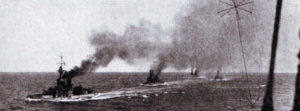
British 4th Battle Squadron at sea: The squadron was led by Admiral Jellicoe’s flagship HMS Iron Duke at the Battle of Jutland on 31st May 1916
4th Battle Squadron (Battleships) commanded by Vice‑Admiral Sir Doveton Sturdee:
HMS Iron Duke (Fleet Flagship) 1914-25,000 tons-10X13.5 inch guns-21 knts-1,000

British Battleship HMS Iron Duke. Iron Duke fought at the Battle of Jutland on 31st May 1916 in Vice Admiral Sir Doveton Sturdee’s 4th Battle Squadron as Admiral Jellicoe’s Fleet Flagship
HMS Royal Oak 1916-28,000 tons-8X15 inch guns-23 knts-990
HMS Superb 1909-18,800 tons-10X12 inch guns-21 knts-780
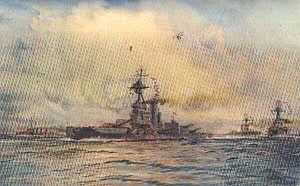
British Battleship HMS Benbow. Benbow fought at the Battle of Jutland 31st May 1916: picture by Lionel Wyllie
HMS Canada 1915-28,600 tons-10X14 inch guns-23 knts-1,176
HMS Benbow 1914-25,000 tons-10X13.5 inch guns-21 knts-1,000
HMS Bellerophon 1909-18,800 tons-10X12 inch guns-21 knts-780
HMS Temeraire 1909-18,800 tons-10X12 inch guns-21 knts-780
HMS Vanguard 1908-19,560 tons-10X12 inch guns-21 knts-820

British Battleship HMS Revenge. Revenge fought at the Battle of Jutland on 31st May 1916 in Vice Admiral Sir Cecil Burney’s 1st Battle Squadron: picture by Lionel Wyllie
1st Battle Squadron (Battleships) commanded by Vice‑Admiral Sir Cecil Burney:
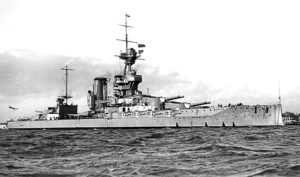
British Battleship HMS Marlborough. Marlborough fought at the Battle of Jutland on 31st May 1916 in Vice Admiral Sir Cecil Burney’s 1st Battle Squadron. The ship was severely damaged
HMS Marlborough 1914-25,000 tons-10X13.5 inch guns-21 knts-1,000
HMS Revenge 1916-28,000 tons-8X15 inch guns-23 knts-990
HMS Hercules 1911-20,225 tons-10X12 inch guns-21 knts-845
HMS Agincourt 1914-27,500 tons-14X12 inch guns-22 knts-1,000
HMS Colossus 1911-20,225 tons-10X12 inch guns-21 knts-831
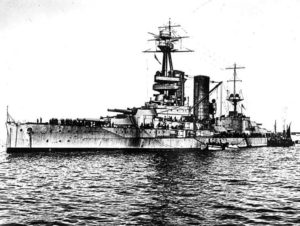
British Battleship HMS Canada. Canada fought at the Battle of Jutland on 31st May 1916 in Vice Admiral Sir Doveton Sturdee’s 4th Battle Squadron
HMS Collingwood 1908-19,560 tons-10X12 inch guns-21 knts-820
HMS Neptune 1909-19,680 tons-10X12 inch guns-22 knts-820
HMS St Vincent 1909-19,560 tons-10X12 inch guns-21 knts-820
Attached ships:
HMS Boadicea (light cruiser) 1908-3,300 tons-10X4 inch guns-25 knts-317
HMS Blanche (light cruiser) 1909-3,350 tons-8X4 inch guns-25 knts-314
HMS Bellona (light cruiser) 1909-3,300 tons-10X4 inch guns-25 knts-317
HMS Active (light cruiser) 1912-3,440 tons-10X4 inch guns-25 knts-325
HMS Oak (destroyer) 1912-765 tons-2X4 inch guns-32 knts-70
HMS Abdiel (minelayer) 1687 tons-3X4 inch guns & 70 mines-34 knts-110

British Battle Cruiser HMS Invincible. Invincible was Rear-Admiral Hood’s flagship in the 3rd Battle Cruiser Squadron at the Battle of Jutland on 31st May 1916. Invincible blew up after being struck by a number of shells
3rd Battle Cruiser Squadron commanded by Rear‑Admiral Hon. H. L. A. Hood:
HMS Invincible 1908-17,250 tons-8X12 inch guns-28 knts-1,031
HMS Inflexible 1908-17,250 tons-8X12 inch guns-28knts-1,000
HMS Indomitable 1908-18,000 tons-8X12 inch guns–25 knts-1,000

British Heavy Cruiser HMS Defence. Defence was sunk with heavy loss of life at the Battle of Jutland on 31st May 1916 as flagship of the 1st Cruiser Squadron commanded by Rear-Admiral Sir Robert Arbuthnot
1st Cruiser Squadron commanded by Rear‑Admiral Sir Robert Arbuthnot:
HMS Defence 1907-14,600 tons-4X9.2 inch & 10X7.5 inch guns-23 knts-755
HMS Warrior 1905-13,550 tons-6X9.2 inch & 4X7.5 inch guns-23 knts-704
HMS Duke of Edinburgh 1904-13,550 tons-6X9.2 inch & 10X6 inch guns-22.5 knts-704
HMS Black Prince 1904-13,550 tons-6X9.2 inch & 10X6 inch guns-22.5 knts-704
2nd Cruiser Squadron:
HMS Minotaur 1906-14,600 tons-4X9.2 inch & 6X6 inch guns-23 knts-755
HMS Hampshire 1903-10,850 tons-4X7.5 inch & 10X6 inch guns-22 knts-653
HMS Cochrane 1905-13,550 tons-6X9.2 inch & 4X7.5 inch guns-23 knts-704
HMS Shannon 1906-14,600 tons-4X9.2 inch & 10X7.5 inch guns-23 knts-755
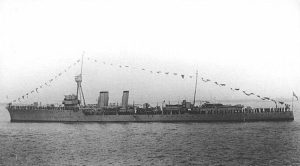
British Light Cruiser HMS Calliope. Calliope fought at the Battle of Jutland on 31st May 1916 in the 4th Light Cruiser Squadron
4th Light Cruiser Squadron:
HMS Calliope 1914-3,759 tons-4X6 inch guns-28 knts-324
HMS Caroline 1914-3,750 tons-4X6 inch guns-28 knts-325
HMS Constance 1915-3,750 tons-4X6 inch guns-28.5 knts-323
HMS Royalist 1915-3,500 tons-3X6 inch guns-28.5 knts-318
HMS Comus 1914-3,750 tons-4X6 inch guns-28.5 knts-325
HMS Canterbury 1914-3,750 tons-4X6 inch guns-28.5 knts-323

British Light Cruiser HMS Canterbury. Canterbury fought at the Battle of Jutland on 31st May 1916. Canterbury’s navigating officer Lieutenant Cuthbert Coppinger was awarded the Distinguished Service Cross. See ‘Coppinger of Jutland’

British Light Cruiser HMS Caroline. Caroline fought at the Battle of Jutland on 31st May 1916. Caroline is the sole British ship to have survived from Jutland and is on display in Belfast
12th Destroyer Flotilla:
HMS Faulknor 1913-1694 tons-2X4.7 inch & 2X4 inch guns-32 knts-205
HMS Marksman 1914-1024 tons-3X4 inch guns-34 knts-80
HMS Obedient 1916-1024 tons-3X4 inch guns-34 knts-80
HMS Maenad 1914-1024 tons-3X4 inch guns-34 knts-80
HMS Opal1914-1024 tons-3X4 inch guns-34 knts-80

British Destroyer HMS Mary Rose. Mary Rose fought at the Battle of Jutland on 31st May 1916 in the 12th Flotilla
HMS Mary Rose 1914-1024 tons-3X4 inch guns-34 knts-80
HMS Marvel 1914-1024 tons-3X4 inch guns-34 knts-80
HMS Menace 1914-1024 tons-3X4 inch guns-34 knts-80
HMS Nessus 1914-1024 tons-3X4 inch guns-34 knts-80
HMS Narwhal 1914-1024 tons-3X4 inch guns-34 knts-80
HMS Mindful 1915-1024 tons-3X4 inch guns-34 knts-80
HMS Onslaught 1914-1024 tons-3X4 inch guns-34 knts-80
HMS Munster 1914-1024 tons-3X4 inch guns-34 knts-80
HMS Nonsuch 1914-1024 tons-3X4 inch guns-34 knts-80
HMS Noble1914-1024 tons-3X4 inch guns-34 knts-80
HMS Mischief 1914-1024 tons-3X4 inch guns-34 knts-80
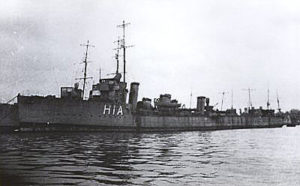
British Destroyer HMS Spitfire. Spitfire fought at the Battle of Jutland on 31st May 1916 in the 4th Destroyer Flotilla. She took part in torpedo attacks on the German battleship line
11th Destroyer Flotilla:
HMS Castor (light cruiser flotilla leader) 1916-3,750 tons-4X6 inch guns-28.5 knts-323
HMS Kempenfelt (light cruiser) 1915-1700 tons-4X4 inch guns-34 knts-104
HMS Ossory 1914-1024 tons-3X4 inch guns-34 knts-80
HMS Mystic 1914-1024 tons-3X4 inch guns-34 knts-80
HMS Moon 1914-890 tons-3X4 inch guns-35 knts-79
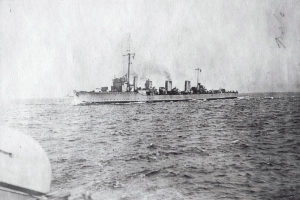
British Flotilla Leader HMS Broke. Broke fought at the Battle of Jutland on 31st May 1916 as a destroyer flotilla leader. She was severely damaged during the night-time torpedo attack on the German battleship line
HMS Morning Star 1914-890 tons-3X4 inch guns-35 knts-79
HMS Magic 1914-1024 tons-3X4 inch guns-34 knts-80
HMS Mounsey 1914-890 tons-3X4 inch guns-35 knts-79
HMS Mandate 1914-1024 tons-3X4 inch guns-34 knts-80
HMS Marne 1914-1024 tons-3X4 inch guns-34 knts-80
HMS Minion1914-1024 tons-3X4 inch guns-34 knts-80
HMS Manners 1914-1024 tons-3X4 inch guns-34 knts-80
HMS Michael 1914-1024 tons-3X4 inch guns-34 knts-80
HMS Mons 1914-1024 tons-3X4 inch guns-34 knts-80
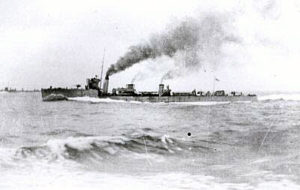
British Destroyer HMS Achates. Achates fought at the Battle of Jutland on 31st May 1916 in the 4th Destroyer Flotilla. She took part in one of the night-time torpedo attacks on the German battleship line
HMS Martial 1914-1024 tons-3X4 inch guns-34 knts-80
HMS Milbrook 1914-1024 tons-3X4 inch guns-34 knts-80
4th Destroyer Flotilla:
HMS Tipperary (class flotilla leader) 1914-2000 tons-6X4 inch guns-31 knts-197
HMS Broke (class flotilla leader) 1914-2000 tons-6X4 inch guns-31 knts-197
HMS Achates 1912-982 tons-3X4 inch guns-30 knts-76
HMS Porpoise 1913-934 tons-3X4 inch guns-29 knts-76
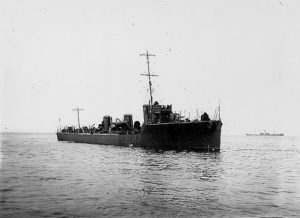
British Destroyer HMS Shark. Shark was sunk at the Battle of Jutland on 31st May 1916 her captain Commander Loftus Jones winning a posthumous Victoria Cross
HMS Spitfire 1913-935 tons-3X4 inch guns-29 knts-76
HMS Unity 1913-954 tons-3X4 inch guns-31 knts-76
HMS Garland 1913-936 tons-3X4 inch guns-29 knts-76
HMS Ambuscade 1913-935 tons-3X4 inch guns-30 knts-76
HMS Ardent 1912-936 tons-3X4 inch guns-29 knts-76
HMS Sparrowhawk 1915-1075 tons-3X4 inch guns-36 knts-90
HMS Contest 1912-936 tons-3X4 inch guns-29 knts-76
HMS Shark 1915-1075 tons-3X4 inch guns-36 knts-90
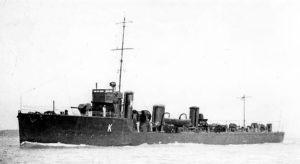
British Destroyer HMS Ardent. Ardent fought at the Battle of Jutland on 31st May 1916 in the 4th Destroyer Flotilla. She took part in one of the night-time torpedo attacks on the German Battleship line and was lost with most of her crew
HMS Acasta 1912-936 tons-3X4 inch guns-29 knts-76
HMS Ophelia 1914-1024 tons-3X4 inch guns-34 knts-80
HMS Christopher 1913-938 tons-3X4 inch guns-29 knts-76
HMS Owl 1913-936 tons-3X4 inch guns-29 knts-76
HMS Hardy 1912-898 tons-3X4 inch guns-32 knts-76
HMS Midge 1913-936 tons-3X4 inch guns-29 knts-76
Submarines: E55, E26 and D1
German Imperial Navy High Seas Fleet Order of Battle on 31st May 1916:
3rd Squadron (Battleships) commanded by Rear-Admiral Behncke
5th Division
SMS König 1913-25,390 tons-10X12 inch guns-21.5 knts-1,100 (increased to between 1,284 and 1,315 across the class for Jutland)
SMS Grosser Kurfürst 1913-25,390 tons-10X12 inch guns-21.5 knts-1,100 (increased to between 1,284 and 1,315 across the class for Jutland)

German Battleship SMS Grosser Kurfürst. Grosser Kurfürst fought at the Battle of Jutland on 31st May 1916 in the 5th Division of Rear-Admiral Behncke’s 3rd Squadron: picture by Claus Bergen
SMS Kronprinz 1913-25,390 tons-10X12 inch guns-21.5 knts-1,100 (increased to between 1,284 and 1,315 across the class for Jutland)
SMS Markgraf 1913-25,390 tons-10X12 inch guns-21.5 knts-1,100 (increased to between 1,284 and 1,315 across the class for Jutland)
6th Division
SMS Kaiser 1912-24,330 tons-10X12 inch guns-20 knts-1,088 (increased to between 1,249 and 1,278 across the class for Jutland)
SMS Kaiserin 1913-24,330 tons-10X12 inch guns-20 knts-1,088 (increased to between 1,249 and 1,278 across the class for Jutland)
SMS Prinzregent Luitpold 1913-24,330 tons-10X12 inch guns-20 knts-1,088 (increased to between 1,249 and 1,278 across the class for Jutland)

German Battleship SMS Friedrick der Grosse Admiral Scheer’s Fleet Flagship at the Battle of Jutland on 31st May 1916
1st Squadron (Battleships) commanded by Vice-Admiral Schmidt
1st Division
SMS Friedrick der Grosse (Fleet Flagship) 1913-24,330 tons-10X12 inch guns-20 knts-1,088 (increased to between 1,249 and 1,278 across the class for Jutland)
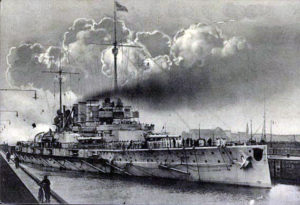
German Battleship SMS Ostfriesland. Ostfriesland fought at the Battle of Jutland on 31st May 1916 in the 1st Division of Vice-Admiral Schmidt’s 1st Battle Squadron
SMS Ostfriesland 1911-22,440 tons-12X12 inch guns-20.5 knts-1,100 (increased to between 1,284 and 1,390 across the class for Jutland)
SMS Thüringen 1911-22,440 tons-12X12 inch guns-20.5 knts-1,100 (increased to between 1,284 and 1,390 across the class for Jutland)
SMS Helgoland 1911-22,440 tons-12X12 inch guns-20.5 knts-1,113 (increased to between 1,284 and 1,390 across the class for Jutland)
SMS Oldenburg 1912-22,440 tons-12X12 inch guns-20.5 knts-1,100 (increased to between 1,284 and 1,390 across the class for Jutland)
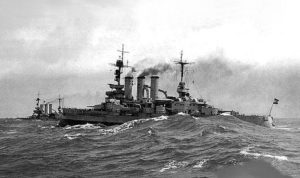
German Battleships of the Nassau Class forming the 2nd Division of Vice-Admiral Schmidt’s 1st Battle Squadron at the Battle of Jutland on 31st May 1916
2nd Division
SMS Posen 1910-18,570 tons-12X11 inch guns-20 knts-1,008 (increased to between 1,124 and 1,139 across the class for Jutland)
SMS Rheinland 1910-18,570 tons-12X11 inch guns-20 knts-1,008 (increased to between 1,124 and 1,139 across the class for Jutland)
SMS Nassau 1910-18,570 tons-12X11 inch guns-20 knts-1,008 (increased to between 1,124 and 1,139 across the class for Jutland)
SMS Westfalen 1910-18,570 tons-12X11 inch guns-20 knts-1,008 (increased to between 1,124 and 1,139 across the class for Jutland)

Second Squadron of the German High Seas Fleet comprising pre-Dreadnought Battleships commanded by Rear-Admiral Mauve at the Battle of Jutland on 31st May 1916
2nd Squadron (Pre-Dreadnought Battleships) commanded by Rear-Admiral Mauve
3rd Division
SMS Deutschland 1904-13,200 tons-4X11 inch guns-19 knts-729 (additional crew for Jutland not known)

German pre-Dreadnought battleship SMS Deutschland squadron flagship of Admiral Mauve’s Second Squadron at the Battle of Jutland on 31st May 1916
SMS Hessen 1903-13,200 tons-4X11 inch guns-18 knts-743 (additional crew for Jutland not known)
SMS Pommern 1905-13,200 tons-4X11 inch guns-19 knts-729 (additional crew for Jutland not known)

German Battleship SMS Schleswig-Holstein firing the opening shots of the Second World War in 1939 at Danzig. Schleswig-Holstein fought at the Battle of Jutland 31st May 1916: picture by Claus Bergen
4th Division
SMS Hannover 1905-13,200 tons-4X11 inch guns-19 knts-729 (additional crew for Jutland not known)
SMS Schlesien 1906-13,200 tons-4X11 inch guns-19 knts-729 (additional crew for Jutland not known)
SMS Schleswig-Holstein 1906-13,200 tons-4X11 inch guns-19 knts-729 (additional crew for Jutland not known)

German pre-Dreadnought Battleships SMS Schlesien and SMS Schleswig-Holstein of Admiral Mauve’s Second Squadron at the Battle of Jutland on 31st May 1916
Cruisers:
1st Scouting Group (Battle Cruisers) commanded by Vice-Admiral Hipper
SMS Lützow (Flagship) 1916-26,180 tons-8X12 inch guns-26.4 knts-1,112 (increased to 1,391 for Jutland)
SMS Derfflinger 1914-26,180 tons-8X12 inch guns-26.4 knts-1,112 (increased to 1,391 for Jutland)

German Battle Cruiser SMS Seydlitz. Seydlitz fought at the Battle of Jutland on 31st May 1916 in Vice-Admiral Hipper’s 1st Scouting Group
SMS Seydlitz 1913-24,594 tons-10X11 inch guns-26.5 knts-1,068 (increased to 1,425 for Jutland)
SMS Moltke 1912-22,616 tons-10X11 inch guns-25 knts-1,053 (increased to 1,355 for Jutland)
SMS von der Tann 1911-19,064 tons-8X11 inch guns-27 knts-910 (increased to 1,174 for Jutland)
2nd Scouting Group (Light Cruisers) commanded by Rear-Admiral Boedicker
SMS Frankfurt 1915-5120 tons-8X5.9 inch guns-28 knts-474
SMS Wiesbaden 1915-5120 tons-8X5.9 inch guns-28 knts-474
SMS Pillau 1914-4350 tons-8X5.9 inch guns-28 knts-372
SMS Elbing 1914-4350 tons-8X5.9 inch guns-28 knts-372
4th Scouting Group (Light Cruisers) commanded by Commodore von Reuter
SMS Stettin 1907-3550 tons-10X4.1 inch guns-23 knts-350
SMS München 1904-3250 tons-10X4.1 inch guns-22 knts-303
SMS Hamburg 1903-3250 tons-10X4.1 inch guns-22 knts-303
SMS Frauenlob 1903-3250 tons-10X4.1 inch guns-22 knts-303
SMS Stuttgart 1906-3550 tons-10X4.1 inch guns-23 knts-350
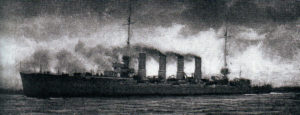
German Light Cruiser SMS Rostock. Rostock was the ‘First Leader’ of Torpedo Boats at the Battle of Jutland on 31st May 1916 and was sunk in the battle
Destroyer (Grosse Torpedoboote) Flotillas:
SMS Rostock (First Leader of Torpedo Boats) 1914-4800 tons-12X4.1 inch guns-29 knts-373
1st Flotilla
(1st Half Flotilla)
SMS G39 (Leader) 1915-1051 tons-3X3.45 inch guns-34 knts-87
SMS G40 1915-1051 tons-3X3.45 inch guns-34 knts-87
SMS G38 1915-1051 tons-3X3.45 inch guns-34 knts-87
SMS S32 1913-971 tons-3X3.45 inch guns-33.5 knts-83
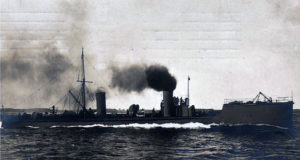
German Torpedo Boat (Destroyer) 1916. Torpedo Boats of this type fought at the Battle of Jutland on 31st May 1916
3rd Flotilla
SMS S53 (Leader) 1915-1074 tons-3X3.5 inch guns-34 knts-85
(5th Half Flotilla)
SMS V71 1915-1188 tons-3X4.1 inch guns-34 knts-85
SMS V73 1915-1188 tons-3X4.1 inch guns-34 knts-85
SMS G88 1915-1188 tons-3X4.1 inch guns-33.5 knts-85
(6th Half Flotilla)
SMS S54 1915-1074 tons-3X4.1 inch guns-34 knts-85
SMS V48 1915-1106 tons-3X3.45 inch guns-34.5 knts-87
SMS G42 1915-971 tons-3X4.1 inch guns-33.5 knts-87
5th Flotilla
SMS G11 (Leader) 1912-573 tons-2X3.45 inch guns-33.5 knts-74
(9th Half Flotilla)
SMS V2 1911-697 tons-2X3.45 inch guns-32 knts-74
SMS V4 1911-697 tons-2X3.45 inch guns-32 knts-74
SMS V6 1913-697 tons-2X3.45 inch guns-32 knts-74
SMS V1 1911-697 tons-2X3.45 inch guns-32 knts-74
SMS V3 1913-697 tons-2X3.45 inch guns-32 knts-74
(10th Half Flotilla)
SMS G8 1911-573 tons-2X3.45 inch guns-32 knts-74
SMS V5 1911-697 tons-2X3.45 inch guns-32 knts-74
SMS G7 1911-573 tons-2X3.45 inch guns-32 knts-74
SMS G9 1912-573 tons-2X3.45 inch guns-32 knts-74
SMS G10 1912-573 tons-2X3.45 inch guns-32 knts-74

German Torpedo Boat SMS S50 of 12th Half Flotilla 6th Flotilla moving at speed to execute a torpedo attack at the Battle of Jutland on 31st May 1916
7th Flotilla
SMS S24 (Leader) 1913-695 tons-2X3.45 inch guns-32.5 knts-74
(13th Half Flotilla)
SMS S15 1912-695 tons-2X3.45 inch guns-32.5 knts-74
SMS S17 1912-695 tons-2X3.45 inch guns-32.5 knts-74
SMS S20 1912-695 tons-2X3.45 inch guns-32.5 knts-74
SMS S16 1912-695 tons-2X3.45 inch guns-32.5 knts-74
SMS S18 1912-695 tons-2X3.45 inch guns-32.5 knts-74
(14th Half Flotilla)
SMS S19 1912-695 tons-2X3.45 inch guns-32.5 knts-74
SMS S23 1913-695 tons-2X3.45 inch guns-32.5 knts-74
SMS V189 1911-783 tons-2X3.45 inch guns-32 knts-84
SMS V186 1910-783 tons-2X3.45 inch guns-32 knts-84
SMS Regensburg Light Cruiser (Second Leader of Torpedo Boats) 1914-4900 tons-7X5.9 inch guns-27 knts-364
2nd Flotilla
SMS B98 (Leader) 1915-1843 tons-4X3.45 inch guns-36.5 knts-114
(3rd Half Flotilla)
SMS G101 1914-1734 tons-4X3.45 inch guns-33.5 knts-104
SMS G102 1914-1734 tons-4X3.45 inch guns-33.5 knts-104
SMS B112 1915-1843 tons-4X3.45 inch guns-36.5 knts-114
SMS B97 1914-1843 tons-4X3.45 inch guns-36.5 knts-114
(4th Half Flotilla)
SMS B109 1915-1843 tons-4X3.45 inch guns-36.5 knts-114
SMS B110 1915-1843 tons-4X3.45 inch guns-36.5 knts-114
SMS B111 1915-1843 tons-4X3.45 inch guns-36.5 knts-114
SMS G103 1914-1734 tons-4X3.45 inch guns-33.5 knts-104
SMS G104 1914-1734 tons-4X3.45 inch guns-33.5 knts-104

German Torpedo Boat SMS V44 in action at the Battle of Jutland on 31st May 1916 as part of the German 6th Flotilla: picture by Willy Stoewer. SMS V44 has been discovered beached in Portsmouth harbour
6th Flotilla
SMS G41 (Leader) 1915-971 tons-3X3.45 inch guns-33.5 knts-87
(11th Half Flotilla)
SMS V44 1915-1106 tons-3X3.45 inch guns-34.5 knts-87
SMS G87 1915-1188 tons-3X4.1 inch guns-33.5 knts-85
SMS G86 1915-1188 tons-3X4.1 inch guns-33.5 knts-85
(12th Half Flotilla)
SMS V69 1915-1188 tons-3X4.1 inch guns-34 knts-85
SMS V45 1915-1106 tons-3X3.45 inch guns-34.5 knts-87
SMS V46 1915-1106 tons-3X3.45 inch guns-34.5 knts-87
SMS S50 1915-1074 tons-3X3.45 inch guns-34 knts-85
SMS G37 1914-1051 tons-3X3.45 inch guns-34 knts-87
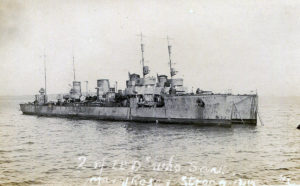
Two German Torpedo Boats involved in sinking HMS Mary Rose and Strongbow on 17th October 1917 in Scapa Flow November 1918
9th Flotilla
V28 (Leader) 1914-975 tons-3X3.45 inch guns-33.5 knts-83
(17th Half Flotilla)
SMS V27 1914-975 tons-3X3.45 inch guns-33.5 knts-83
SMS V26 1914-975 tons-3X3.45 inch guns-33.5 knts-83
SMS S36 1914-971 tons-3X3.45 inch guns-33.5 knts-83
SMS S51 1915-1074 tons-3X4.1 inch guns-34 knts-85
SMS S52 1915-1074 tons-3X4.1 inch guns-34 knts-85

German sailors on SMS Frederick der Grosse in Scapa Flow after the Armistice in November 1918. This ship fought at the Battle of Jutland on 31st May 1916 as Admiral Scheer’s Flagship
(18th Half Flotilla)
SMS V30 1914-975 tons-3X3.45 inch guns-33.5 knts-83
SMS S34 1914-971 tons-3X3.45 inch guns-33.5 knts-83
SMS S33 1914-971 tons-3X3.45 inch guns-33.5 knts-83
SMS V29 1914-975 tons-3X3.45 inch guns-33.5 knts-83
SMS S35 1914-971 tons-3X3.45 inch guns-33.5 knts-83
Submarines:
U46, U67, U21, U22, U52, U24, U70, U32, U51, U63, U66, U47, U44, U43.
Airships:
L9, L14, L16, L21, L23, L11, L17, L22, L24, L13, L30.
Manning differences between the British and German Fleets:
A major role of the Royal Navy was to protect Britain’s world-wide empire. Royal Navy ships were designed, manned and equipped to support their crews at sea for months and to operate from any port in Britain or abroad.
The German Imperial Navy came into existence after 1890 with a more limited primary role of defeating the Royal Navy in the North Sea or the Imperial Russian Navy in the Baltic Sea. Most of the German naval bases were clustered in the short area of Germany’s North Sea coast; Wilhelmshaven on the Jade River, Bremerhaven on the Weser River, Cuxhaven on the Elbe River and Emden. At the eastern Baltic Sea end of the Kiel Canal lay the port of Kiel. In each port an extensive range of fleet support facilities was built.
During the First World War the German capital ships operated primarily in the North and Baltic Seas, often away from port for no more than two nights (other than the voyage of the battle cruiser SMS Goeben through the Mediterranean to Turkey in 1914).
Operations elsewhere in the world were left to the ships considered inadequately gunned and armoured for the German High Seas Fleet; for example SMS Scharnhorst and Gneisenau in the Pacific in 1914 (see the Battles of Coronel and the Falkland Islands).
The highly effective German light cruisers operated everywhere in the World.
The decisive battle with the Royal Navy’s Grand Fleet was expected to take place in the North Sea with the German High Seas Fleet at sea for a matter of a few days. In the event the German High Seas Fleet left harbour for the Battle of Jutland on 30th May and returned on 1st June 1916, two nights at sea.

British 1st Battle Squadron at sea: ‘HMS Revenge, Resolution, Royal Oak, Royal Sovereign and Ramillies. The Squadron fought at the Battle of Jutland 31st May 1916
Design of German capital ships reflected this strategic expectation. There was no long-term accommodation on board ship. Crews lived in barracks in the base ports. Feeding, logistics and administration were conducted ashore. Mess decks, kitchens, stores and administrative offices were not required on the scale of a Royal Navy capital ship, enabling the space to be used for operational purposes and for compartments to be smaller, making the ships less vulnerable.
Administrative personnel such as cooks, storemen and pay staff were not required on board in the numbers necessary for a British capital ship and were replaced by operational sailors (engine room, armaments, sailing and communications staff).
Whenever German capital ships left harbour with the expectation of action the crews were augmented by up to 25%, perfectly feasible for a short voyage, thereby ensuring that every operational department was fully manned and had supernumeraries to replace casualties.
The Royal Navy’s Grand Fleet did not have these advantages. Its ships devoted large areas to the accommodation, feeding and support of their crews, carried out by substantial non-combatant staffs.
In the manning of all Royal Navy ships a balance had to be struck between the personnel allocated to each department and the number of sailors that could be accommodated on the ship. Inevitably few departments were manned to an ideal level.
There was no general provision in the Royal Navy for supernumeraries to augment a ship’s crew for specific operations. In any case with the Grand Fleet’s move to Scapa Flow at the outset of the First World War there were no facilities on Orkney to provide such support.
A further burden on the Royal Navy in the North Sea and the Channel inhibiting gunnery and fleet training was the obligation to cover the constant army traffic to France (no soldier was lost to enemy action while crossing the Channel) and to protect the English coast against German raids, involving a rigorous regime of patrolling throughout the North Sea up to the German coast (enforcing the blockade of Germany was the responsibility of special squadrons).
In contrast German ships emerged from their bases only to conduct manoeuvres, training and gunnery practice on the Baltic Sea ranges, to which a considerable amount of time was devoted, or for specific operations.
Comparison of crew sizes between HMS Tiger and SMS Derfflinger:
The British HMS Tiger and the German SMS Derfflinger were comparable battle cruisers, similar in size and armaments. Tiger was commissioned in 1914 and Derfflinger in 1913.
Tiger’s crew was 1,121. Of these around 10% were administrative staff dealing with the crew’s long term needs, so that around 1,010 members of the crew were operational rather than administrative.

British Battle Cruiser HMS Tiger. Tiger fought at the Battle of Jutland on 31st May 1916 in Rear¬-Admiral O. de B. Brock’s 1st Battle Cruiser Squadron part of Admiral Beatty’s Battle Cruiser Fleet
Derfflinger’s standard crew was 1,112, almost the same as Tiger’s, but of these probably only 5% were administrative, with the balance of such staff on shore, so that Derfflinger’s standard operational crew was around 1,056. Derfflinger’s crew was augmented for the Jutland operation by a further 279 officers and sailors, all operational, an operational crew of 1,335 against Tiger’s operational crew of 1,010, giving Derfflinger a 32% advantage in size of operational crew over Tiger.
All the German post-Dreadnought capital ships sailed with a comparable advantage, although not as great as 32% in most cases, over the Royal Navy capital ships.

German Battle Cruiser SMS Derfflinger. Derfflinger fought at the Battle of Jutland in Vice-Admiral Franz Hipper’s 1st Scouting Group
It is not clear whether the German 2nd Squadron, comprising pre-Dreadnought Battleships, sailed with an augmented crew.
This chart sets out the crew numbers for the battle cruisers in Beatty’s and Hipper’s forces.
Battle Cruiser Crews:
| Ship | Crew | |
| British | ||
| HMS Lion | 1,092 | |
| HMS PrincessRoyal | 985 | |
| HMS Queen Mary | 1,185 | |
| HMS Tiger | 1,185 | |
| HMS New Zealand | 853 | |
| HMS Indefatigable | 853 | |
| Total: | 6,153 | |
| Average per ship | 1,025 | |
| German | Augmented Jutland Crew | |
| SMS Lützow | 1,112 | 1,391 |
| SMS Derfflinger | 1,112 | 1,391 |
| SMS Seydlitz | 1,068 | 1,425 |
| SMS Moltke | 1,053 | 1,355 |
| SMS von der Tann | 910 | 1,174 |
| Totals: | 5,255 | 6,753 |
| Average per ship | 1,051 | 1,350 |
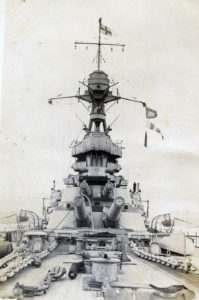
Battleship HMS Barham 1916 A and B Turrets bridge mast and gunnery control centre. Barham fought at the Battle of Jutland on 31st May 1916 as Flagship of Vice Admiral Evan-Thomas’s 5th Battle Squadron in Admiral Beatty’s Battle Cruiser Fleet
The average crew on the British ships was marginally smaller than the standard German crew and comprised a greater proportion of administrative personnel.
With their augmented crews the five German battle cruisers carried 600 more crew than the six British battle cruisers, a 10% advantage overall. The advantage in average individual ship terms became 32% in favour of the German ships with the augmented crews, again with a smaller proportion of administrative personnel.
The operational effect of this superiority was significant. There were more sailors to move ammunition, fight fires and replace casualties at the guns; increasing rates of fire, ensuring safety procedures were not bypassed and remedying damage.
Capital Ships:
All the British Capital Ships that fought at Jutland were completed in 1908 or after and were a maximum of 6 years old at the outbreak of war (compare this with World War Two in which many of the Royal Navy’s non-aircraft carrier capital ships were World War One vintage or at least 20 years old on the outbreak of war).
Royal Navy Capital Ships:
The benchmark for capital ships of all nations was the British battleship HMS Dreadnought completed in 1906. In the period up to and during the First World War battle ships were categorised as ‘Pre-Dreadnought’ or ‘Dreadnought’, such was the influence of this ground-breaking ship.
The Invincible class battle cruisers were completed in 1908. While powerful carrying eight 12 inch guns and fast at 25 ½ knots these ships were under armoured, a failing that proved fatal to Invincible at Jutland. The three ships in the class Invincible (sunk) Inflexible and Indomitable fought at Jutland as part of Rear‑Admiral Hon. H. L. A. Hood’s 3rd Battle Cruiser Squadron.

British Battleship HMS Superb. Superb fought at the Battle of Jutland on 31st May 1916 in Vice Admiral Sir Doveton Sturdee’s 4th Battle Squadron
The Bellerophon class battleships were completed in 1909 with ten 12 inch guns. The class was virtually a repeat of the revolutionary Dreadnought design. All three ships in the class Bellerophon, Superb and Temeraire fought at Jutland in Vice‑Admiral Sir Doveton Sturdee’s 4th Battle Squadron.
The St Vincent class battleships were completed in 1910. The class followed the Bellerophon design and carried ten 12 inch guns. All three ships in the class St Vincent, Collingwood and Vanguard fought at Jutland in Vice‑Admiral Sir Cecil Burney’s 1st Battle Squadron.

British Battleship HMS Collingwood in Rosyth. Collingwood fought at the Battle of Jutland on 31st May 1916 in Vice Admiral Sir Cecil Burney’s 1st Battle Squadron. Prince Albert later King George VI was a member of her crew under the name ‘Mr Johnson’
HMS Neptune battleship was completed in 1911. The layout in Neptune was designed to overcome the limited eight gun broadside of Dreadnought, the Bellerophons and the St Vincents. Several foreign ships could fire ten and twelve gun broadsides. Neptune’s ten 12 inch guns were in a turret layout that permitted ten gun broadsides but was not entirely satisfactory. Neptune fought at Jutland in Vice‑Admiral Sir Cecil Burney’s 1st Battle Squadron.
The Colossus class battleships were completed in 1911. These ships with ten 12 inch guns followed the ‘We want eight and we won’t wait’ public outcry of 1909 over the suspected German ship building programme. These two ships have been described as half-sisters of Neptune with minor changes to that design. Both ships in the class Colossus and Hercules fought at Jutland in Vice‑Admiral Sir Cecil Burney’s 1st Battle Squadron.

British Battle Cruiser HMS Indefatigable. Indefatigable fought at the Battle of Jutland on 31st May 1916 in Rear Admiral W. C. Pakenham 2nd Battle Cruiser Squadron. Indefatigable blew up and sank early in the battle
The Indefatigable class battle cruisers were completed between 1911 and 1913 with eight 12 inch guns. These ships were intended to be battle cruiser versions of Neptune but were instead near repeats of the inadequate Invincible design with fatal consequences at Jutland for Indefatigable. Two of the three ships in the class Indefatigable (sunk) and New Zealand fought at Jutland in Rear‑Admiral W. C. Pakenham’s 2nd Battle Cruiser Squadron, part of Admiral Beatty’s Battle Cruiser Fleet. The third ship HMAS Australia was in ‘dockyard hands’ at the time of Jutland due to a collision in fog with HMS New Zealand.
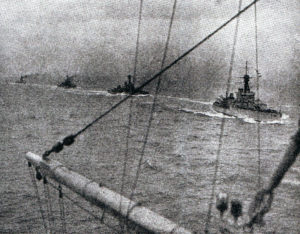
Orion class battleships in the North Sea: HMS Monarch, Thunderer and Conqueror, the photograph taken from HMS Orion. All four ships fought at the Battle of Jutland on 31st May 1916 in Vice Admiral Sir Thomas Jerram’s 2nd Battle Squadron
The Orion class battleships were completed in 1912 as part of the 1909 programme demanded by public clamour. These ships carried ten 13.5 inch guns in turrets placed in the centreline with super firing pairs of turrets forward and aft and one amidships. These were powerful ships. All four ships in the class Orion, Conqueror, Monarch and Thunderer fought at Jutland in Vice‑Admiral Sir Thomas Jerram’s 2nd Battle Squadron.
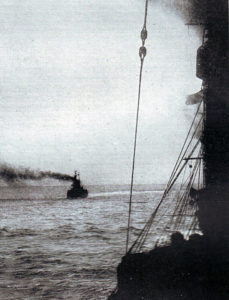
HMS Lion in the North Sea: Lion was Admiral Beatty’s flagship at the Battle of Jutland on 31st May 1916
The Lion class battle cruisers completed in 1912 were the battle cruiser equivalents of the Orions. Conway’s describes these ships and their half-sisters Queen Mary and Tiger as having grave weaknesses. The primary inadequacy was the armour which provided protection only against 11 inch shells and only in places. Lord Fisher was a keen exponent of the battle cruiser believing that protection could be provided by the speed of the ships. Both ships Lion and Princess Royal fought at Jutland in Rear-Admiral O. de B. Brock’s 1st Battle Cruiser Squadron, part of Admiral Beatty’s Battle Cruiser Fleet.
The King George V class battleships were completed in 1912 and 1913. These ships were improved ‘Orions’ with ten 13.5 inch guns in the same layout. Three of the four ships in this class King George V, Centurion and Ajax fought at Jutland in Vice‑Admiral Sir Thomas Jerram’s 2nd Battle Squadron. The fourth ship Audacious was sunk by mines in 1914.

British Battleship HMS Ajax. Ajax fought at the Battle of Jutland on 31st May 1916 in Vice Admiral Sir Thomas Jerram’s 2nd Battle Squadron
HMS Queen Mary battle cruiser completed in 1913 as the battle cruiser equivalent of the King George Vs was effectively a half-sister to the Lion battle cruisers. Queen Mary fought at Jutland in Rear-Admiral O. de B. Brock’s 1st Battle Cruiser Squadron, part of Admiral Beatty’s Battle Cruiser Fleet. Inadequacies in the protection afforded the turrets caused her to explode and sink when hit several times by Derfflinger at Jutland.
The Iron Duke class battleships completed in 1914 were similar to the King George Vs but longer, wider and deeper, with a fire control facility in the heavy tripod foremast from construction while most ships had them added. Three of the four ships in the class Iron Duke (Admiral Jellicoe’s Fleet Flagship), Marlborough (flagship to the 1st Battle Squadron) and Benbow (flagship to the 4th Battle Squadron) fought at Jutland . The fourth ship of the class Emperor of India did not fight at Jutland being ‘in dockyard hands’.
HMS Tiger battle cruiser completed in 1914 was a sister ship to Queen Mary with eight 13.5 inch guns. Her turrets were re-arranged to give a pair of super firing turrets forward and two aft and she was given a stronger secondary armament of 6 inch guns. Tiger lacked adequate armour for a fleet battle as with the other battle cruisers. Tiger fought at Jutland in Rear-Admiral O. de B. Brock’s 1st Battle Cruiser Squadron, part of Admiral Beatty’s Battle Cruiser Fleet.

British Queen Elizabeth Class Battleship HMS Warspite under construction in Plymouth in October 1914. Warspite fought at the Battle of Jutland on 31st May 1916 in Rear Admiral H. Evan Thomas’s 5th Battle Squadron
The Queen Elizabeth class battleships were completed in 1915 and 1916. These ships were given eight of the new 15 inch guns with greater hitting power and range in pairs of super firing turrets forward and aft. To achieve speeds of 24 to 25 knots the ships were fuelled solely by oil. To ensure supply of fuel the British Government bought shares in Iranian oil companies. The construction of these fast battleships made battle cruisers redundant. Four of the five ships in the class fought at Jutland in Rear‑Admiral H. Evan‑Thomas’s 5th Battle Squadron: Barham, Valiant, Malaya and Warspite. Queen Elizabeth was ‘in dockyard hands’.

British Battleship HMS Revenge with British Battle Cruiser HMS Lion in the background. Both ships fought at the Battle of Jutland on 31st May 1916: picture by Lionel Wyllie
The Revenge class battleships completed in 1916 and 1917 were cheaper versions of the Queen Elizabeths having the 15 inch guns but being coal and oil driven. Two of the five Revenge class ships fought at Jutland: Revenge in the 1st Battle Squadron and Royal Oak in the 4th Battle Squadron.
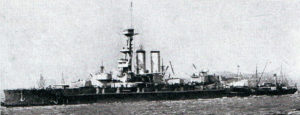
British Battleship HMS Agincourt. Originally destined for the Turkish Navy Agincourt was seized for the Royal Navy and fought at the Battle of Jutland on 31st May 1916 in Vice Admiral Sir Cecil Burney’s 1st Battle Squadron
HMS Erin and Agincourt: these ships completed in 1914 were built for Turkey and seized for the Royal Navy. Erin (ten 13.5 inch guns) was based on the King George V design. Agincourt was a unique design originally for the Brazilian Navy. She was heavily gunned with fourteen 12 inch guns but she was lightly armoured. Both ships fought at Jutland Erin in the 2nd Battle Squadron and Agincourt in the 1st Battle Squadron.
HMS Canada battleship completed in 1915 for the Chilean Navy with ten 14 inch guns was bought for the Royal Navy. Canada fought at Jutland in Vice‑Admiral Sir Doveton Sturdee’s 4th Battle Squadron.
German Imperial Navy Capital Ships:
Kaiser Wilhelm II was determined to have a navy that could rival and outfight Britain’s Royal Navy. Admiral Alfred von Tirpitz oversaw the development of the German Imperial Navy after becoming Secretary of State for the German Reichsmarineamt in 1897.
The section of the German Imperial Navy intended to face the Royal Navy’s Grand Fleet was the High Seas Fleet based in the complex of naval bases on Germany’s North Sea Coast.
The German capital ships in the High Seas Fleet at Jutland came from these ship classes:
The Braunschweig class of five pre-Dreadnought battleships with four 11 inch guns of which SMS Hessen completed in 1903 fought at Jutland in Rear-Admiral Mauve’s 3rd Battle Squadron.

German Battleship SMS Deutschland. Deutschland fought at the Battle of Jutland on 31st May 1916 in Admiral Mauve’s 2nd Squadron of pre-Dreadnought battleships
The Deutschland class of pre-Dreadnought battleships completed between 1904 and 1906 with four 11 inch guns and all of whose five ships fought at Jutland in Rear-Admiral Mauve’s 3rd Battle Squadron: Deutschland, Hannover, Pommern (sunk), Schlesien and Schleswig-Holstein.

German pre-Dreadnought SMS Pommern. Pommern was sunk with no survivors at the Battle of Jutland in the early hours of 1st June 1916 by a torpedo fired from the British 12th Destroyer Flotilla
The Nassau class of battleships Germany’s first Dreadnoughts were completed in 1910. The six 11 inch double gun turrets were arranged with two on each beam that reduced the broadside to only eight guns. They carried characteristic ‘goose-neck’ cranes. All four ships of the class fought at Jutland in Vice-Admiral Schmidt’s 1st Battle Squadron: Nassau, Westfalen, Rheinland and Posen.

German Battleship SMS Helgoland. Helgoland fought at the Battle of Jutland on 31st May 1916 in Vice-Admiral Schmidt’s 1st Battle Squadron
The Helgoland class of battleships was completed in 1911 and 1912 and were considered a considerable improvement on the Nassau design having twelve 12 inch guns while repeating the turret layout. All four ships of the class fought at Jutland in Vice-Admiral Schmidt’s 1st Battle Squadron: Helgoland, Ostfriesland, Thüringen and Oldenburg.

German Battleship SMS Ostfriesland. Ostfriesland fought at the Battle of Jutland on 31st May 1916 in Vice-Admiral Schmidt’s 1st Battle Squadron
SMS Von Der Tann battle cruiser was completed in 1911 with eight 11 inch guns in single turrets forward and aft and two centrally placed. Conways describes Von Der Tann as a considerably better fighting ship than any of the six British battle cruisers. Von Der Tann fought at Jutland in Vice-Admiral Hipper’s 1st Scouting Group.
The Moltke class of battle cruiser completed in 1912 was an improved larger version of Von Der Tann carrying ten 11 inch guns in a single turret forward, two amidships and two super firing turrets aft. Of the class Moltke fought at Jutland in Vice-Admiral Hipper’s 1st Scouting Group while Goeben was in the Mediterranean.

German Battleship SMS Kaiser. Kaiser fought at the Battle of Jutland on 31st May 1916 in Rear-Admiral Behncke’s 3rd Battle Squadron
The Kaiser class of battleships was completed in 1912 and 1913. This class was of a radical new design having a forward turret, two turrets amidships and a pair of super-firing turrets (one firing over the other) aft with ten 12 inch guns producing a 10 gun broadside. Of the five ships in the class four fought at Jutland: Friedrich Der Grosse as Admiral Scheer’s Fleet Flagship and Kaiser, Kaiserin and Prinzregent Luitpold in Rear-Admiral Behncke’s 3rd Battle Squadron.
SMS Seydlitz battle cruiser completed in 1913 was an enlarged version of Moltke with ten 11 inch guns in the same arrangement. Seydlitz fought at Jutland in Vice-Admiral Hipper’s 1st Scouting Group.
The König class of battleships was completed in 1914 and 1915, essentially improved Kaisers with ten 12 inch guns in two super firing turrets forward and two aft and a single turret amidships. All four ships of the class fought at Jutland in Rear-Admiral Behncke’s 3rd Battle Squadron: König, Grosser Kurfürst, Markgraf and Kronprinz.

German Battleship SMS König. König fought at the Battle of Jutland on 31st May 1916 in Rear-Admiral Behncke’s 3rd Battle Squadron
The Derfflinger class of battle cruiser completed in 1914 and 1916 followed a different much improved design from the previous battle cruisers. Eight 12 inch guns were mounted in pairs of super firing turrets forward and aft. Both ships of the class Derfflinger and Lützow (sunk) fought at Jutland in Vice-Admiral Hipper’s 1st Scouting Group, Lützow as Hipper’s Flagship.
Capital Ships at Jutland
| Germany | |||
| Year of Commission: | German Ships: | Weight in tons: | Number of Guns X calibre in inches: |
| 1903 | Hessen | 13,200 | 4 X 11 |
| 1904 | Deutschland | 13,200 | 4 X 11 |
| 1905 | Hannover | 13,200 | 4 X 11 |
| Pommern | 13,200 | 4 X 11 | |
| 1906 | Schlesien | 13,200 | 4 X 11 |
| Schleswig-Holstein | 13,200 | 4 X 11 | |
| 1907 | |||
| 1908 | |||
| 1909 | |||
| 1910 | Nassau | 18,570 | 12 X 11 |
| Westfalen | 18,570 | 12 X 11 | |
| Rheinland | 18,570 | 12 X 11 | |
| Posen | 18,570 | 12 X 11 | |
| 1911 | Helgoland | 22,440 | 12 X 12 |
| Ostfriesland | 22,440 | 12 X 12 | |
| Thüringen | 22,440 | 12 X 12 | |
| Von Der Tann* | 19,064 | 8 X 11 | |
| 1912 | Oldenburg | 22,440 | 12 X 12 |
| Kaiser | 24,330 | 10 X 12 | |
| Moltke* | 22,616 | 10 X 11 | |
| 1913 | Frederich Der Grosse | 24,330 | 10 X 12 |
| Kaiserin | 24,330 | 10 X 12 | |
| Prinzregent Luitpold | 24,330 | 10 X 12 | |
| Seydlitz* | 24,594 | 10 X 11 | |
| 1914 | Grosse Kurfürst | 25,390 | 10 X 12 |
| Derfflinger* | 26,180 | 8 X 12 | |
| 1915 | König | 25,390 | 10 X 12 |
| Markgraf | 25,390 | 10 X 12 | |
| Kronprinz | 25,390 | 10 X 12 | |
| 1916 | Lützow* | 26,180 | 8 X 12 |
| Great Britain | |||
| Year of Commission: | British Ships: | Weight in tons: | Number of Guns X calibre in inches: |
| 1903 | |||
| 1904 | |||
| 1905 | |||
| 1906 | Dreadnought
not at Jutland |
18,110 | 10 X 12 |
| 1907 | |||
| 1908 | Invincible* | 17,250 | 8 X 12 |
| Inflexible* | 17,250 | 8 X 12 | |
| Indomitable* | 17,250 | 8 X 12 | |
| 1909 | Bellerophon | 18,800 | 10 X 12 |
| Superb | 18,800 | 10 X 12 | |
| Temeraire | 18,800 | 10 X 12 | |
| St Vincent | 19,560 | 10 X 12 | |
| 1910 | Collingwood | 19,56 | 10 X 12 |
| Vanguard | 19,560 | 10 X 12 | |
| 1911 | Neptune | 19,680 | 10 X 12 |
| Colossus | 20,225 | 10 X 12 | |
| Hercules | 20,225 | 10 X 12 | |
| Indefatigable* | 18,500 | 8 X 12 | |
| 1912 | New Zealand* | 18,500 | 8 X 12 |
| Orion | 22,200 | 10 X 13.5 | |
| Conqueror | 22,200 | 10 X 13.5 | |
| Monarch | 22,200 | 10 X 13.5 | |
| Thunderer | 22,200 | 10 X 13.5 | |
| Lion* | 26,270 | 8 X 13.5 | |
| Princess Royal* | 26,270 | 8 X 13.5 | |
| 1913 | King George V | 23,000 | 10 X 13.5 |
| Centurion | 23,000 | 10 X 13.5 | |
| Ajax | 23,000 | 10 X 13.5 | |
| Queen Mary* | 26,770 | 8 X 13.5 | |
| 1914 | Iron Duke | 25,000 | 10 X 13.5 |
| Marlborough | 25,000 | 10 X 13.5 | |
| Benbow | 25,000 | 10 X 13.5 | |
| Tiger* | 28,430 | 8 X 13.5 | |
| Erin | 22,780 | 10 X 13.5 | |
| Agincourt | 27,500 | 14 X 12 | |
| 1915 | Barham | 27,500 | 8 X 15 |
| Warspite | 27,500 | 8 X 15 | |
| Canada | 28,600 | 10 X 14 | |
| 1916 | Valiant | 27,500 | 8 X 15 |
| Malaya | 27,500 | 8 X 15 | |
| Revenge | 28,000 | 8 X 15 | |
| Royal Oak | 28,000 | 8 X 15 |
*battle cruiser

British Battleship HMS Vanguard. Vanguard fought at the Battle of Jutland 31st May 1916 in the 4th Battle Squadron commanded by Vice-Admiral Sir Doveton Sturdee

Battleship HMS Neptune 1916. Neptune fought at the Battle of Jutland on 31st May 1916 in Vice Admiral Burney’s First Battle Squadron
Kiel Canal:
The Kiel Canal was built between 1895 and 1897 to connect the German naval bases and the Baltic Sea. The canal was of critical importance to the German Imperial Navy in permitting ease of access to the Baltic where the navy’s training grounds were situated. Between 1907 and 1914 the canal was widened and deeper locks added to permit the passage of the German Imperial Navy’s larger post-Dreadnought battleships. Until the widening took place the limited access of the canal influenced the size of Germany’s new ships, giving rise to a class of battleship that was too small to be of great use in the First World War.

Kiel Canal, a German light cruiser SMS Dresden passing through before the First World War. Dresden fought at Coronel and the Falkland Islands being finally cornered and scuttled in 1915
Gunnery Training:
The Kiel Canal gave German ships quick access to the naval training areas in the Baltic Sea, in which great emphasis was placed on gunnery. In every action the British were impressed by the accuracy of German shooting.
Gunnery training for the Grand Fleet was conducted in the unreliable sea conditions north of Orkney with the constant threat from German U boats.
Beatty’s battle cruiser force based in the Firth of Forth had no access to a sea range for gunnery practice on its main armament. It was a standing criticism of the British battle cruisers that their gunnery was not as good as the German. The 5th Battle Squadron came under Beatty’s command in May 1916 replacing Hood’s 3rd Battle Cruiser Squadron while Hood’s ships conducted much needed gunnery training at Scapa Flow.
Destroyers and Torpedo Boats:
Two naval weapons developed at the end of the eighteenth century, the mine and the torpedo, were considered a major threat to capital ships.
New small boats were built to fire torpedoes. Ships to counter these ‘torpedo boats’ were labelled ‘torpedo boat destroyers’, quickly elided in the Royal Navy to just ‘destroyers’.

Kaiser Wilhelm II inspecting the Imperial German High Seas Fleet before the First World War: picture by Willie Stoewer
In the Royal Navy and other navies the destroyer became a class of small ship with a wide range of duties, including the role of the original torpedo boats. Destroyers were given a powerful if small gun armament.
The Germans did not formally adopt the title ‘destroyer’ in the First World War. The ships remained ‘torpedo boats’.
The roles of British destroyers and German torpedo boats in the Fleet Action at Jutland were identical. Flotillas of these ships led by light cruisers provided the capital ships with cover against submarine attack or attack by the opposing destroyers/torpedo boats. When the opportunity arose the destroyer/torpedo boat flotillas launched torpedo attacks against the opposing capital ship line. Such attacks took place at various stages during the Battle of Jutland. The most striking example is the attack of the Royal Navy’s 12th Destroyer Flotilla on the German Fleet at dawn on 1st June 1916 leading to the loss of the German battleship SMS Pommern.
An important role for the German torpedo boat flotillas which they performed twice during the Battle of Jutland was to generate a smoke screen to mask the withdrawal by turning away of the German battleship line.
The difference between the destroyers/torpedo boats of the two sides was that many of the German torpedo boats were smaller and less well gun armed than the British destroyers, placing them at a disadvantage (the effect of this difference was graphically illustrated in the Texel Action on 17th October 1914).
Mines:
By May 1916 minefields had been laid by British and German ships at various important positions in the North Sea to restrict activity by the opposing fleets.

British Battleship HMS Audacious sinking after striking German mines in October 1914: picture by Lionel Wyllie
Of particular concern were the techniques of releasing mines into the path of pursuing ships and the tactical laying of mines on the course of ships on the move.
One of the mines laid by the Royal Navy minelayer HMS Abdiel sent by Jellicoe to lay mines in the path of the withdrawing German Fleet early on the morning of 1st June 1916 caused severe damage to the German battleship SMS Ostfriesland.
Submarines:
With the temporary abandonment of unrestricted U Boat warfare in the Atlantic Admiral Scheer had available to him a large proportion of the U Boat force to support the German High Seas Fleet in the Jutland Foray. Submarine ambushes were put in place outside all the Royal Navy’s main bases to await the British ships putting to sea. None were torpedoed.
The British submarines were equally unsuccessful. E55, E26 and D1 were ordered to attack the German Fleet south of the Horn Reefs as it withdrew to harbour after the Battle of Jutland. The orders to the British submarines were to remain deep until 2nd June. This order was not altered to address the change in the situation and the German Fleet passed over the submarines in safety.
There was no place for the submarines in the battle itself being too slow underwater to keep up with the surface ships. Nevertheless there was a number of unjustified ‘submarine scares’ during the fighting.
Air Reconnaissance:
Jellicoe’s Seaplane ship was left behind and took no part in the Battle of Jutland. A seaplane from Beatty’s Seaplane Ship HMS Engadine provided him with confirmation that the German battle cruisers were present at the outset of the battle. No further use was made of the seaplanes during the battle.
Scheer was given invaluable information by German airships during the battle. The difficulty was that airships could only fly in near wind free conditions. None of the aircraft could assist at night.
The previous battle of the First World War is Gallipoli IV
The next battle of the First World War is the Battle of Jutland Part II

